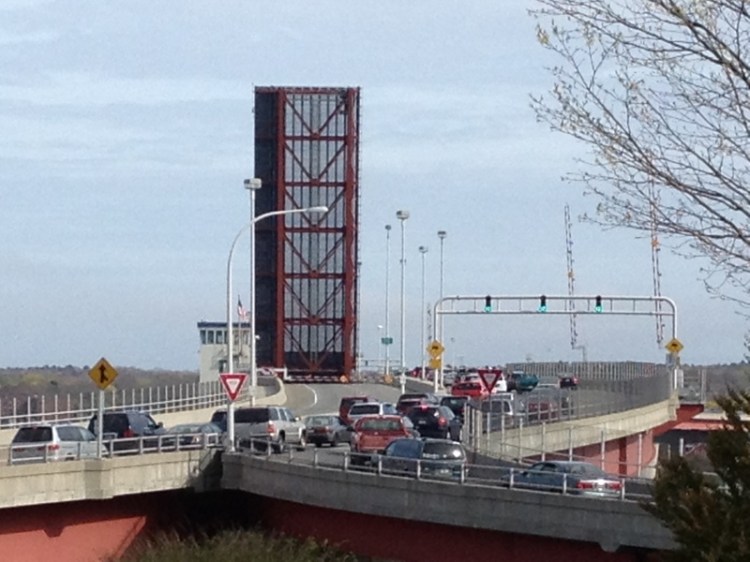First in an occasional series answering your questions about Maine.
Why can’t we get some kind of schedule or advance notice so we can avoid the Casco Bay Bridge when the drawbridge is open for passing ships?
We hear you.
What commuter traveling between Portland and South Portland or Cape Elizabeth doesn’t know the feeling? You’re on a tight schedule and approaching the bridge when you see flashing yellow lights or, worse, the giant spans of the drawbridge sticking up into the air as a long line of vehicles waits for a massive ship to inch its way up or down the Fore River.

Well, as it turns out, there is a little-known service that can give motorists advance notice of bridge openings – maybe enough time to avoid sitting in a traffic jam. However, the technology has some serious limitations thanks to a well-established federal law gives ships the absolute right of way.
Common sense suggests vessels should follow a predictable schedule to minimize disruption to traffic flowing over the busy bridge. It seems like someone could at least post a weekly schedule online or email it to subscribers so they can plan ahead and take a different route. After all, 15,000 vehicles cross over the bridge each day, while fewer than two ships a day pass under it. (The bridge opened 630 times to let ships through last year.)
In this case, cast common sense and predictability to the wind. There’s no schedule; there’s never going to be a schedule.
Maritime traffic takes precedence over land vehicles because of a 126-year-old federal navigation law that makes it a crime for bridge operators to refuse to open a bridge to vessels. Violating the law can lead to a $25,000 fine.
And motorists aren’t the only ones who don’t get advance notice. Folks in charge of bridge operations have just minutes to get the cars stopped and the drawbridge open.
“What happens is the ships send us an alarm, either a radio call or an alarm, and from that point we have 15 minutes from where they are going to be to open the bridge,” said Ben Foster, deputy chief engineer for the Maine Department of Transportation Bureau of Maintenance and Operations.
“The code of federal regulations is that drawbridges must be opened promptly and fully when the signal is given.”
Even harbor pilots, who board ships and work with tugboats to guide large tankers and cargo vessels into port, don’t get much advance warning. When a ship needs to get upriver or downriver, they don’t have to wait until it’s a convenient time and they don’t have to wait for rush-hour traffic to clear.

Ships have the right of way under federal law, so motorists – and bridge tenders – get little notice of drawbridge openings. Press Herald file photo
The people piloting the ship have other issues to consider, like squeezing a tanker carrying tens of thousands of gallons of heating oil through Portland Harbor without bumping into anything.
Weather, tides and currents, onboard and onshore malfunctions, crew availability and more all factor into when a ship comes into port and for how long, said Portland Harbor Master Kevin Battle. And it’s not just big commercial freighter ships that trigger a bridge opening and have the right of way. Pleasure yachts with tall enough masts and other vessels also can force it open.
Given the unpredictability of marine traffic, planning a commute to avoid an open bridge is virtually impossible.
But don’t despair. We do have some good news that could give you a little edge. To borrow a well-worn aphorism – there’s an app for that.
For almost 20 years, Maine has subscribed to 511, a web-based service that collects traffic data and reports vehicle crashes, roadwork, unusual traffic and other measures. Kind of like an early version of Google maps or Waze.
Today, branded as New England 511, an alert service covers Maine, New Hampshire and Vermont. Drivers can create profiles and create “trips” that give them alerts and updates via text message or email about specific routes. For example, if you regularly commute into Portland from Saco, creating a trip to monitor that stretch of the Maine Turnpike for anything that might delay your drive into work could be helpful.
Luckily, it even works for the Casco Bay Bridge. Arrange an alert through the website and at least you’ll get a 15-minute heads-up that the bridge is about to go up. Not perfect, but enough of a lead to potentially avoid a traffic jam.
Don’t feel bad if this is news to you. Given the system’s potential to avoid – or at least mitigate – traffic headaches, New England 511 is surprisingly underused. About 600 users have alerts for the Casco Bay Bridge.
In fact, the service seems to be a well-kept secret among all Maine motorists. Just over 2,200 users have signed up for the MyTrip service, about one-twentieth of the licensed drivers in the state.
Send questions/comments to the editors.




Success. Please wait for the page to reload. If the page does not reload within 5 seconds, please refresh the page.
Enter your email and password to access comments.
Hi, to comment on stories you must . This profile is in addition to your subscription and website login.
Already have a commenting profile? .
Invalid username/password.
Please check your email to confirm and complete your registration.
Only subscribers are eligible to post comments. Please subscribe or login first for digital access. Here’s why.
Use the form below to reset your password. When you've submitted your account email, we will send an email with a reset code.